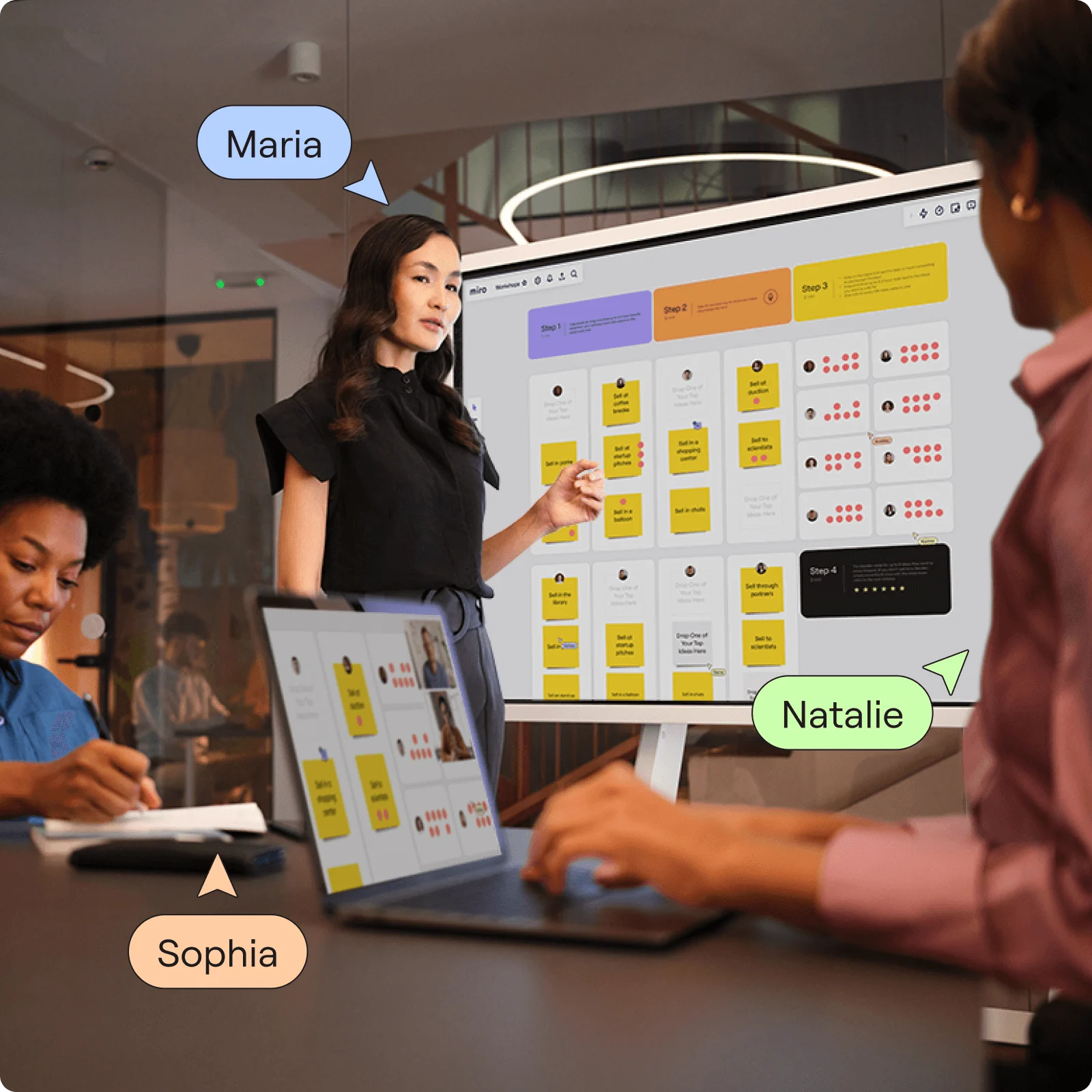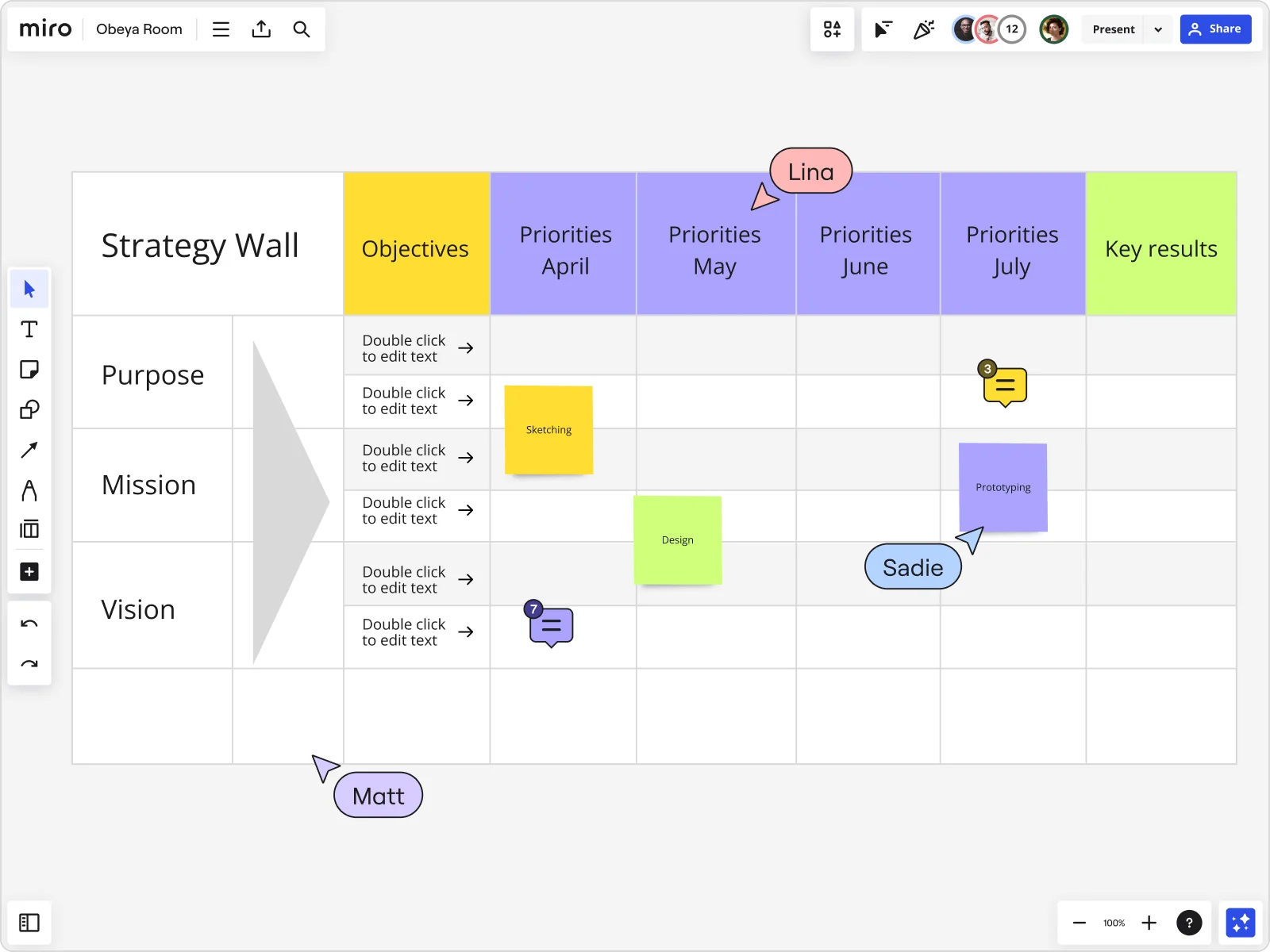
Table of contents
Table of contents
What is an Obeya room?

Summary
In this guide, you will learn:
- What an Obeya room is: a centralized physical or virtual space for cross-functional collaboration, visual management, and decision-making, rooted in Lean and Toyota methodologies
- Key elements of an Obeya room: visual displays like KPI dashboards, charts, whiteboards, and performance walls to simplify data and track progress
- How Obeya rooms foster real-time information sharing, break down silos, and align teams for faster problem-solving and decision-making
- The evolution from physical to digital and hybrid Obeya rooms, supporting remote collaboration and real-time updates
- Benefits of Obeya rooms: improved communication, transparency, faster decisions, proactive problem-solving, and increased productivity
- Best practices for implementing Obeya rooms: define goals, collaboratively design the space, select tools, train teams, and regularly review the process
Try Miro now
Join thousands of teams using Miro to do their best work yet.
Obeya rooms, often referred to simply as "obeyas," are dynamic spaces that revolutionize the way businesses manage processes and foster collaboration. Rooted in the philosophy of Lean Manufacturing and Toyota's methodologies, these rooms are dedicated to visual management and enhanced decision-making.
Historical background and origins
The concept of Obeya rooms traces back to the lean principles pioneered by Toyota in the mid-20th century. Toyota recognized that by visually representing complex workflows and data, teams could identify inefficiencies and improve processes more effectively.
Purpose of the Obeya room
An Obeya room serves as a centralized hub where teams gather to analyze, discuss, and optimize processes. It's a physical or virtual space adorned with visual aids, KPI dashboards, and cross-functional collaboration tools.
Philosophical foundations of the Obeya concept
The essence of Obeya lies in its deep connection to Lean Manufacturing and the power of visual representation. By visualizing workflows, bottlenecks, and performance indicators, businesses gain a holistic understanding of their operations.
Link to Lean Manufacturing and Toyota
Obeya rooms borrow from Lean principles by embracing continuous improvement, waste reduction, and teamwork. Toyota's influence is evident in the emphasis on eliminating waste and maximizing value.
The role of visual management
Visual management forms the backbone of Obeya rooms. Walls or visual workspaces adorned with charts, graphs, and KPI displays allow teams to quickly understand the state of operations and make informed decisions.

Key elements of an Obeya Room
Central to the Obeya room are its vital components that ensure a seamless and effective approach to management and collaboration.
Visuals and their importance
The walls of an Obeya room act as information canvases. Visualizing data simplifies complex processes and fosters better understanding among team members, enabling quick problem-solving.
Common KPIs and performance indicators displayed
Obeya rooms showcase key performance indicators that align with business goals. These metrics provide real-time insights, helping teams detect trends and make data-driven decisions.
Tools and technologies for enhancement
From physical whiteboards to digital collaboration platforms, Obeya rooms leverage various tools to enhance productivity. Technological solutions enable virtual collaboration, ensuring flexibility and accessibility.
Benefits of implementing an Obeya Room
The advantages of adopting Obeya rooms extend across different aspects of business management and collaboration. Advantages in decision-making processes Obeya rooms expedite decision-making by providing real-time insights into projects and processes. The visual nature enables swift analysis and consensus-building. Promoting cross-functional collaboration These rooms foster collaboration by bringing diverse teams together to brainstorm, share insights, and collectively solve challenges, transcending departmental boundaries. Early problem detection and real-time course correction Visual management allows teams to spot bottlenecks and deviations early on. This timely identification enables adjustments to ensure project success.
Steps for setting up an Obeya Room
Establishing a successful Obeya room demands careful planning, layout, and consideration of its role within your organization.
Step 1: Define objectives and scope
Begin by setting clear objectives for your Obeya room. Determine:
- What specific processes or projects will the room address?
- Outline the scope to avoid overloading the room with excessive information.
- Engage with key stakeholders to align objectives with strategic goals.
- Understand the pain points and areas of improvement that the Obeya room should address. By focusing on well-defined objectives, the room's impact becomes more measurable and actionable.

Step 2: Identify stakeholders and teams
Identify the key stakeholders who will benefit from the Obeya room. Involve representatives from relevant teams to ensure comprehensive insights and cross-functional collaboration.
The selection of stakeholders should include representatives from various departments and levels of the organization, promote a holistic understanding, and encourage cross-pollination of ideas. By involving diverse stakeholders, the Obeya room becomes a space for collaboration that transcends departmental boundaries.
Step 3: Choose an appropriate location (or opt for virtual)
Select a central location that's easily accessible to all involved teams. The location should promote interaction and engagement. Consider these factors:
- Proximity to team workspaces and visibility within the organization: The physical location of the Obeya room can significantly impact its effectiveness.
- Choose a space that encourages spontaneity and encourages people to engage: Consider factors such as acoustics, lighting, and overall ambiance to create an environment conducive to productive discussions and brainstorming.
- If opting for a virtual obeya room, integrate digital collaboration tools: Select a platform that supports real-time interaction, sharing of documents, and video conferencing for remote teams.
- When integrating digital tools, security and ease of use become paramount: Choose platforms that prioritize data privacy and offer intuitive interfaces. Test the digital tools extensively to ensure they seamlessly facilitate collaboration and data sharing, enhancing the virtual Obeya experience.
Step 4: Plan the layout or space for engagement
Design the layout or online space to foster engagement:
- Arrange workstations, displays, and seating to encourage communication and collaboration.
- Ensure clear visibility of all visual aids and KPIs.
- The layout should promote both formal and informal interactions.
- Incorporate comfortable seating arrangements that encourage natural discussions.
- Arrange visual aids strategically to guide the flow of conversation. By designing a layout that fosters engagement, you facilitate the sharing of insights and ideas among team members.
Step 5: Curate relevant visual aids
Determine the types of visual aids needed:
- This can include: process maps, KPI dashboards, timelines, and problem-solving boards.
- Choose visuals that align with your objectives and can be easily understood.
- The selection of visual aids requires a deep understanding of the information that needs to be conveyed. Each visual aid should tell a clear and concise story. Consider using data visualization techniques that resonate with your audience, making complex data comprehensible at a glance.
Step 7: Establish a maintenance protocol
Define how the room will be maintained and updated.
- Assign responsibilities for regularly updating visuals, replacing outdated information, and ensuring that technology is in working order.
- Maintenance is a crucial aspect of an effective Obeya room.
- Establish a clear protocol for regular upkeep. Designate team members responsible for maintaining the visual aids, updating data, and troubleshooting any technical glitches. A well-maintained Obeya room ensures that the information presented remains accurate and actionable.
Step 8: Launch and training
Introduce the Obeya room to stakeholders and teams.
- Provide training on using the room effectively, including how to interpret visual aids and collaborate within the space.
- The launch phase is an opportunity to build enthusiasm and confidence among stakeholders.
- Conduct comprehensive training sessions that cover not only technical aspects but also the principles of visual management.
- Empower users to use the Obeya room's capabilities to drive informed decision-making.
Step 9: Collect feedback and iterate
Encourage ongoing feedback from users.
- Gather insights on the room's effectiveness, layout, and the information displayed.
- Use this feedback to make necessary improvements and refinements.
- Feedback collection should be an ongoing process, fostering a culture of continuous improvement.
- Create mechanisms for users to share their experiences and suggestions.
- Regularly analyze feedback to identify patterns and areas for enhancement.
- Iterative improvements based on user input ensure that the Obeya room evolves to meet changing needs.
Challenges in Obeya implementation
While Obeya rooms offer many benefits, successful implementation requires addressing potential challenges.
Common mistakes and how to avoid them
Avoid information overload by focusing on key data. Encourage participation to prevent the room from becoming an isolated initiative.
Ensuring continuous team engagement
Sustain engagement through regular updates and interactive sessions. Address resistance to change with education and showcase success stories.
Avoiding information overload
Balancing data and visuals is crucial. Present only relevant information to maintain clarity and prevent overwhelming team members.
Bridging the gap: Virtual Obeya Rooms
The digital age introduces virtual Obeya rooms, which retain the essence of traditional Obeya while offering unique advantages.
Differences and Similarities with Physical Obeya Rooms Virtual Obeya rooms replicate the visual management and collaboration aspects of their physical counterparts while introducing distinct features.
Real-time Accessibility for Remote Teams Virtual Obeya rooms transcend geographical barriers, enabling global teams to collaborate seamlessly. Real-time access to visual aids, data, and discussions promotes inclusivity.
Flexibility in Time Zones and Scheduling Teams across different time zones can engage in the same virtual space, fostering collaboration without constraints. This flexibility ensures that insights are shared and decisions are made despite varying schedules.
Data-driven Insights and Analysis Digital platforms facilitate instant data capture, enabling teams to analyze trends and patterns more efficiently. Automated reporting tools provide deeper insights for proactive decision-making.
Advantages and Limitations of Going Virtual
While virtual Obeya rooms offer unique benefits, they also come with potential challenges that need to be addressed for successful implementation.
Advantages of Virtual Obeya Rooms Efficient global collaboration, reduced travel costs, and enhanced accessibility are some of the primary advantages. Remote teams can participate without hindrance.
Addressing Challenges in Technology Adoption Ensure that team members are comfortable with digital tools. Provide training and support to bridge the gap between varying levels of technological proficiency.
Safeguarding Data Security and Privacy Select secure and reliable digital platforms to protect sensitive information. Implement data encryption and access controls to mitigate risks.
Maintaining a Collaborative Atmosphere Virtually Foster a sense of community by encouraging interactive discussions and engagement. Leverage features like video conferencing to enhance real-time interactions.
Monitoring and measuring for continuous improvement
Regularly assess the impact of the Obeya room and embrace the spirit of continuous improvement.
Monitor and measure the impact
- Measure improvements in decision-making, collaboration, and process optimization.
- Use quantitative and qualitative data to gauge success.
- Impact measurement involves both quantitative metrics and qualitative anecdotes.
- Monitor how the Obeya room influences key performance indicators, such as reduced cycle times and increased process efficiency. Additionally, gather success stories that highlight specific instances where the room's insights led to tangible benefits.
Continuous improvement
- Regularly revisit and refine the Obeya room's objectives, visuals, and layout to align with evolving business needs and strategies.
- Continuous improvement is not limited to processes; it extends to the Obeya room itself.
- Regularly assess whether the room continues to meet its intended objectives.
- Explore new visualization techniques, gather input from stakeholders, and adapt the room's elements to ensure its relevance in an ever-changing business landscape.
Future perspectives on Obeya Rooms
As technology evolves, the future holds exciting possibilities for the role of Obeya rooms in visual management.
Trends and innovations in visual management
The integration of AI, data analytics, and real-time reporting will amplify the power of visual management. Predictive analytics will enable proactive decision-making.

Merging traditional and modern approaches
The future will likely see a harmonious blend of physical and virtual Obeya rooms, catering to diverse business needs. Hybrid models will combine the strengths of both approaches.
Power Obeya collaboration with Miro
Obeya rooms epitomize the fusion of Lean principles and modern technology to empower teams with visual insights, streamline processes, and drive collaborative success. By embracing the concepts outlined in this comprehensive guide, businesses can embark on a journey of enhanced decision-making, cross-functional harmony, and sustainable growth.
Author: Miro Team
Last update: October 10, 2025